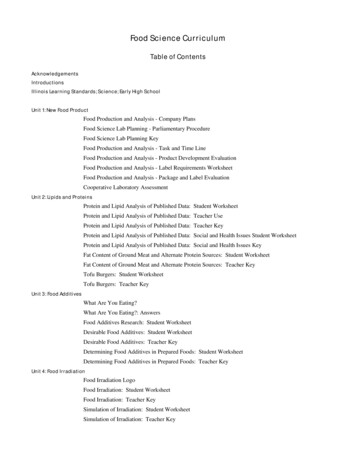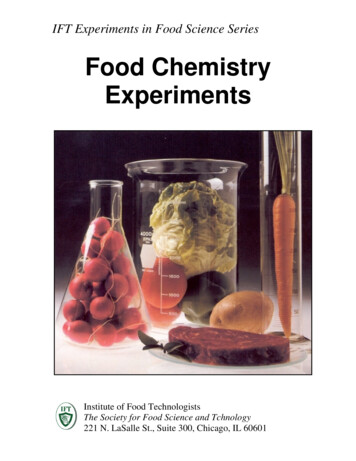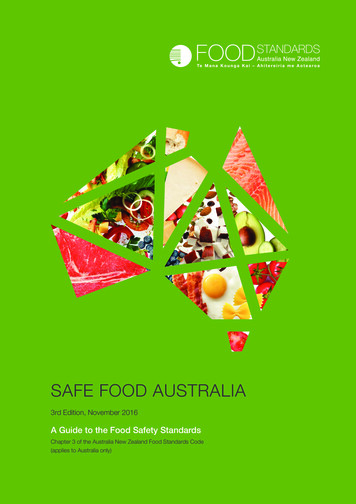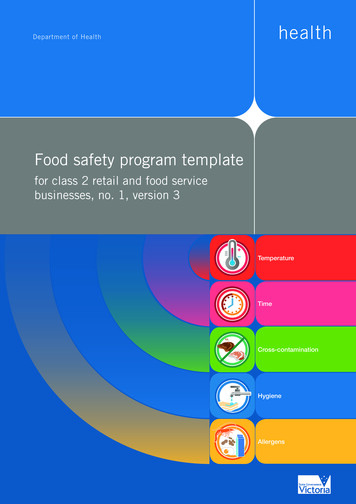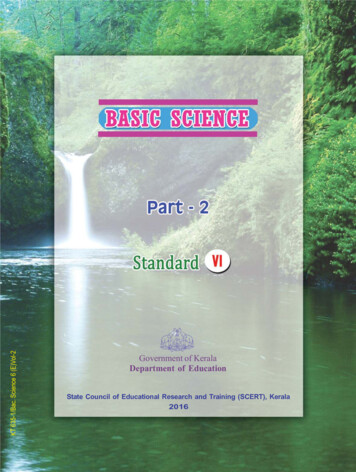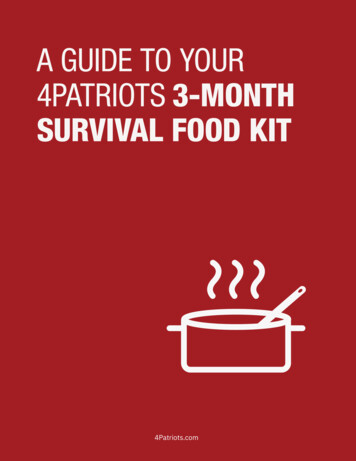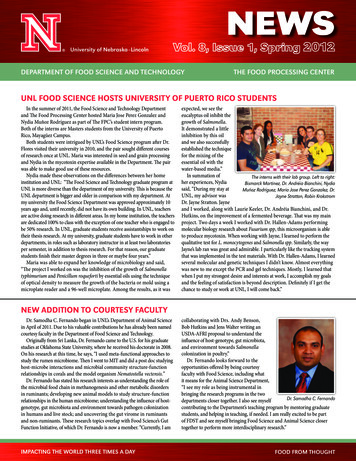
Transcription
NEWSUniversity of Nebraska–LincolnDEPARTMENT OF FOOD SCIENCE AND TECHNOLOGYTHE FOOD PROCESSING CENTERUNL Food Science Hosts University of Puerto Rico StudentsIn the summer of 2011, the Food Science and Technology Departmentand The Food Processing Center hosted Maria Jose Perez Gonzalez andNydia Muñoz Rodríguez as part of The FPC’s student intern program.Both of the interns are Masters students from the University of PuertoRico, Mayagüez Campus.Both students were intrigued by UNL’s Food Science program after Dr.Flores visited their university in 2010, and the pair sought different coursesof research once at UNL. Maria was interested in seed and grain processingand Nydia in the mycotoxin expertise available in the Department. The pairwas able to make good use of these resources.Nydia made these observations on the differences between her homeinstitution and UNL: “The Food Science and Technology graduate program atUNL is more diverse than the department of my university. This is because theUNL department is bigger and older in comparison with my department. Atmy university the Food Science Department was approved approximately 10years ago and, until recently, did not have its own building. In UNL, teachersare active doing research in different areas. In my home institution, the teachersare dedicated 100% to class with the exception of one teacher who is engaged tobe 50% research. In UNL, graduate students receive assistantships to work ontheir thesis research. At my university, graduate students have to work in otherdepartments, in roles such as laboratory instructor in at least two laboratoriesper semester, in addition to thesis research. For that reason, our graduatestudents finish their master degrees in three or maybe four years.”Maria was able to expand her knowledge of microbiology and said,“The project I worked on was the inhibition of the growth of Salmonellatyphimurium and Penicillum roqueforti by essential oils using the techniqueof optical density to measure the growth of the bacteria or mold using amicroplate reader and a 96-well microplate. Among the results, as it wasexpected, we see theeucalyptus oil inhibit thegrowth of Salmonella.It demonstrated a littleinhibition by this oiland we also successfullyestablished the techniquefor the mixing of theessential oil with thewater-based media.”In summation ofThe interns with their lab group. Left to right:her experiences, NydiaBismarck Martinez, Dr. Andréia Bianchini, Nydiasaid, “During my stay atMuñoz Rodríguez, Maria Jose Perez Gonzalez, Dr.UNL, my advisor wasJayne Stratton, Robin KrokstromDr. Jayne Stratton. Jayneand I worked, along with Laurie Keeler, Dr. Andréia Bianchini, and Dr.Hutkins, on the improvement of a fermented beverage. That was my mainproject. Two days a week I worked with Dr. Hallen-Adams performingmolecular biology research about Fusarium spp, this microorganism is ableto produce mycotoxin. When working with Jayne, I learned to perform thequalitative test for L. monocytogenes and Salmonella spp. Similarly, the wayJayne’s lab ran was great and admirable. I particularly like the tracking systemthat was implemented in the test materials. With Dr. Hallen-Adams, I learnedseveral molecular and genetic techniques I didn’t know. Almost everythingwas new to me except the PCR and gel techniques. Mostly, I learned thatwhen I put my strongest desire and interests at work, I accomplish my goalsand the feeling of satisfaction is beyond description. Definitely if I get thechance to study or work at UNL, I will come back.”New Addition to Courtesy FacultyDr. Samodha C. Fernando began in UNL’s Department of Animal Sciencein April of 2011. Due to his valuable contributions he has already been namedcourtesy faculty in the Department of Food Science and Technology.Originally from Sri Lanka, Dr. Fernando came to the U.S. for his graduatestudies at Oklahoma State University, where he received his doctorate in 2008.On his research at this time, he says, “I used meta-functional approaches tostudy the rumen microbiome. Then I went to MIT and did a post doc studyinghost-microbe interactions and microbial community structure-functionrelationships in corals and the model organism Nematostella vectensis.”Dr. Fernando has stated his research interests as understanding the role ofthe microbial food chain in methanogenesis and other metabolic disordersin ruminants; developing new animal models to study structure-functionrelationships in the human microbiome; understanding the influence of hostgenotype, gut microbiota and environment towards pathogen colonizationin humans and live stock; and uncovering the gut virome in ruminantsand non-ruminants. These research topics overlap with Food Science’s GutFunction Initiative, of which Dr. Fernando is now a member. “Currently, I amIMPACTING THE WORLD THREE TIMES A Daycollaborating with Drs. Andy Benson,Bob Hutkins and Jens Walter writing anUSDA-AFRI proposal to understand theinfluence of host-genotype, gut microbiota,and environment towards Salmonellacolonization in poultry.”Dr. Fernando looks forward to theopportunities offered by being courtesyfaculty with Food Science, including whatit means for the Animal Science Department,“I see my role as being instrumental inbringing the research programs in the twoDr. Samodha C. Fernandodepartments closer together. I also see myselfcontributing to the Department’s teaching program by mentoring graduatestudents, and helping in teaching, if needed. I am really excited to be partof FDST and see myself bringing Food Science and Animal Science closertogether to perform more interdisciplinary research.”FOOD FROM THOUGHT
FOOD SCIENCE & TECHNOLOGYA Message From Dr. FloresRight: Dr. Rolando A. FloresGreetings from the Department of Food Science and Technologyand The Food Processing Center at UNL! In this issue we highlightsome of our students and faculty activities during the last monthsof 2011.In September, the Food Science Club sold ice cream at theApplejack Festival in Nebraska City. The ice cream was sold out oftheir new trailer, purchased with funds from a grant of the KimmellFoundation. Dean Elbert Dickey commended the club for helping tomake the university’s presence at the Apple Jack Festival a successfulpromotion of what university outreach can do. In October, three ofour students, Brooke Grossenbacher, Ashley Bernstein, and KatinaTalley, were appointed as CASNR student ambassadors for the 20112012 academic year.This issue of the newsletter features a research article by Dr. JoeBaumert on food allergen quantitative risk assessment. Dr. Baumerthimself was recently featured in an article by Food Chemical Newson the challenges related to food allergens in labeling and processing.The article described him as being one of the leading experts onfood allergens.Dr. Jens Walter is continuing a successful collaboration withDr. Nathalie Juge of the Institute of Food Research in Norwich,UK. Their studies of Lactobacillus reuteri/host interactions andthe functional characterization of the enzymes of gut microbiotahave already produced two outstanding publications. One of Dr.Walter’s doctoral students, Kenzi Clark, is working with Dr. Juge inNorwich on these functional characterizations with an eye towardsagricultural applications.Dr. Robert Hutkins has been writing a monthly column for theLincoln Journal-Star as “the Food Doc”. There he answers pressingquestions about food safety, food science, and the technologybehind food. You can view his columns at http://go.unl.edu/ja8.Dr. Harshavardhan Thippareddi has recently been in Bogotá,Colombia; Santiago, Chile; and Mysore, India to participate in, orconduct, workshops and symposia on food safety and risk assessment.In large part thanks to Dr. John Rupnow, the Department ofFood Science and Technology has established collaborativepartnerships through student exchanges with universities inArgentina, Colombia, Costa Rica, and Honduras. Students fromthese institutions are nominated to participate in one semesterinternships in our Department. Most recently we have hosted LuciaMiceli García, who is mentioned in our visiting scholars section.This has proven very beneficial to the students, home institutions,and the Food Science and Technology Department. Outstandingstudents such as Jihan Cepeda, Andrés Doblado Maldonado,María X. Maldonado-Gómez, and María Quintero participatedin this internship and went on to pursue advanced degrees inour Department.In the last few months, FPC personnel have done quite a bit ofinternational traveling and world exposure for the benefit of UNLand Nebraska. In August, Dr. Andréia Bianchini and myself presentedat the Universidad del Valle in Guatemala at the Grain Qualityfor Flour Manufacturing Workshop; Dr. Gordon Smith, adjunctprofessor, traveled with us and was part of the workshop. Also inAugust, Drs. Wajira Ratnayake, Vicki Schlegel, and Marilynn Schnepfpresented at the Sino-U.S. Nutrition and Health Seminar in Beijing,China. In September, The FPC hosted the state of Nebraska’s ReverseTrade Mission, which consisted of representatives from China,Japan, Europe, and South America. In November, FPC ProductDeveloper Julie Reiling presented on food labeling requirements atthe Food Industry Forum in San Juan, Puerto Rico. Since July, I havebeen serving on the advisory board of the Regional Virtual FoodInspection School in Central America and the Dominican Republic,which should be up and running by 2013. Just last month, I traveledwith Vice Chancellor Green and an IANR team to Brazil to developa strategic relationship with the Escola Superior de Agricultura “Luizde Queiroz,” part of the University of São Paulo in Piracicaba, Brazil;this should lead to exchanges of faculty, research and students anddemonstrate the quality of our programs.The FPC is also offering a new service. The Food ProcessingManagement online course allows food industry professionals toreceive top notch training from Food Science and FPC faculty andstaff from anywhere on the globe. You can read about this programin this newsletter, and you can also visit the program’s website atfpm.unl.edu.In addition to these activities, the Department’s talent is visible inrecent grant funded projects. A selection of grants recently awardedto the Food Science and Technology Department and The FoodProcessing Center is on page three.In this newsletter, we share more recent events and accomplishments.I hope you enjoy it, and I hope you’ll get in touch with us. Our numberis (402) 472-2831. We’re always happy to hear from alumni andcommunicate their news.2 I spring 2012 I IMPACTING THE WORLD THREE TIMES A Day
ALUMNISelected GrantsFood Science and TechnologyLeaves Alumnus Well PreparedDr. Greg Knudsen recently received his PhD from the University of Nebraska Medical School.He credits his education in the Food Science and Technology Department at UNL for giving himthe knowledge and discipline to succeed.Originally from Laurel, Nebraska, Dr. Knudsen had decided to study food science beforecoming to UNL, “because of the many unique career opportunities it provides and my interestin the creative use of science and math.” With this in mind, Dr. Knudsen was drawn to UNLbecause of the dedication apparent in the program. “I visited UNL’s Food Science Program duringhigh school and it was obvious that the faculty and students were truly passionate about theprogram. This passion, in addition to facilities such as The Food Processing Center and DairyStore, interested me in UNL’s Food Science Program.”While at UNL, Dr. Knudsen conducted his research with the Food Allergy Research andResource Program (FARRP). “Specifically, I looked at the impact of the Food Allergen Labelingand Consumer Protection Act (FALCPA) on cookie labeling.”Dr. Knudsen graduated from UNL with a B.S. in Food Science in 2007. From there he attendedpharmacy school at the University of Nebraska Medical Center where he received a Doctorof Pharmacy Degree in May of 2011. He currently manages Clinic Pharmacy in Boone, Iowa.“During pharmacy school it was readily apparent how much my experiences at the FoodScience Program were helping me succeed. Going into pharmacy school, I had a very strongchemistry, microbiology, and math/engineering background. This allowed me to spendless time on these areas and master pharmacy coursework less familiar to me. Lastly, mybackground in food allergies aided me in writing a continuing education article on drugallergies for the Nebraska Pharmacist’s Association’s bimonthly publication, the NebraskaMortar & Pestle.”ConAgraDr. Jeyamkondan Subbiah“Modeling of Interaction of Microwaveswith Food and Packaging (Shielded)” 102,400 (6 months)Kansas State UniversityDr. Harshavardhan Thippareddi“Development and Validation ofPredictive Models for Growth of ShigaToxin Producing E. coli” 43,999 (1 year)Nebraska Department of AgricultureDr. Wajira Ratnayake, Dr. Devin Rose“Great Northern Bean Flour as aFunctional Ingredient inGluten-Free Snack Foods” 44,907 (2 years)Nebraska Department of AgricultureDr. Vicki Schlegel“Ability of Pinto Beans and GreatNorthern Beans to Modulate DNAConformation to Protectagainst Inflammation” 42,350 (1 year)Nebraska Dry Bean CommissionDr. Vicki Schlegel“Development of Health PromotingRecipes using Dry EdibleBeans-Hot Dogs (Phase 2)” 1800 (1 year)Pioneer Hi-Bred International, Inc.Dr. Richard Goodman“In Vitro IgE Testing of a Biotech SoybeanEvent LEPI 2800” 200,470 (18 months)USDA - FASDr. Jeyamkondan Subbiah, Dr.Harshavardhan Thippareddi“Borlaug Fellowship Program - Asia 2011” 27,672 (1 year)USDA – RBEGDr. Stephen Pharr, Mark Hutchison,Suzanne Weeder Einspahr“Growth Services for Rural Food Firms” 65,794 (1 year)If you would prefer to receive your newsletterelectronically, please send your email addressto mstandley2@unl.edu. The University istrying to find ways to “go green” and this is anexcellent way for us to do our part. Thank you.IMPACTING THE WORLD THREE TIMES A Day I spring 2012 I 3
StudentsGraduates ofthe B.S. ProgramKong Hoong ChanNy LeAlex NelsonRichard SpinnerGraduates ofthe M.S. ProgramMaria X. Maldonado-GómezThesis: “Studies on the adherence propertiesof plant lectins and bacterial adhesins andtheir inhibition by prebiotics oligosaccharidesand bovine colostrums fractions”Dr. Robert Hutkins, AdvisorKristina E. MooreThesis: “Biological Analysis of Prebiotics inVarious Processed Food Matrices”Dr. Robert Hutkins, AdvisorMauricio Redondo SolanoThesis: “Effect of sodium nitrite, sodiumerythorbate and organic acid salts ongermination and outgrowth of Clostridiumperfringens spores in ham during cooling”Dr. Harshavardhan Thippareddi, AdvisorJelena SpiricThesis: “Identification and Characterizationof Putative Allergens in Pecan Species”Dr. Joseph Baumert, AdvisorNew M.S. GraduateStudentsKaty Merckel Shares HerEnthusiasmRight: Katy MerckelKary Merckel is an undergraduate in the Department of Food Science and Technology.Originally from Moravia, New York, she’s been planning to be here for quite some time. “Infifth grade we were each assigned a state to do a project on. I was assigned Nebraska. I had beenfascinated with the state ever since. I had already decided on food science when I was lookingat colleges, and noticed UNL had a really good program. I applied and it turned out to work thebest for me!”Her interest in food science is a more recent discovery. “In high school, I was invited to aprogram hosted by the Cornell Food Science Department. After that, I knew that it was exactlywhat I wanted to do. It was exciting and all of my classmates were jealous that I had foundsomething to major in that I was so sure about.”Katy began at UNL in fall 2009. She says her favorite class so far has been Food Science101, Introduction to Food Science, “because it really affirmed that I had chosen the best majorever. I loved learning so much about something I use every day but never thought too muchabout. Dr. Cuppett has had a huge positive impact on my time here at UNL. She taught 101and introduced me to all things food science, taught me how to write a good research paper,and always has an entertaining anecdote about how food was when she was a kid. Plus, she hasawesome sweaters.”“I have been working with Dr. Zeece on a UCARE project researching the presence of bioactive proteins in fermented meat products. It’s a really good experience,” she said. On herfuture, Katy states, “I am currently planning on putting off graduation for a semester in orderto study abroad, hopefully in Africa. I don’t think I will end up in industry . . . I am reallyinterested in food crises, both in the US and abroad, and hope to do something to have apositive impact on that.”Nirosh D. AluthgeAdvisor – Dr. Samodha FernandoYiwei LiuAdvisors – Drs. Wajira Ratnayake andRolando FloresLucia Miceli GarcíaAdvisors – Drs. Wajira Ratnayake andJayne StrattonNew PhD GraduateStudentsMaria X. Maldonado-GómezAdvisor – Dr. Robert Hutkins4 I spring 2012 I IMPACTING THE WORLD THREE TIMES A Day
StudentsMaría Elisa Pérez-Muñoz, NutritionistTurned Gnotobiotic ResearcherLeft: María Elisa Pérez-MuñozMaría Elisa Pérez-Muñoz is a PhD student at the Department ofFood Science and Technology advised by Dr. Daniel Peterson. MaríaElisa is originally from Mayagüez, Puerto Rico, and became a clinicaldietician after receiving a degree in Nutrition and Dietetics fromthe University of Puerto Rico, Río Piedras Campus. “The science ofnutrition helps prevent diseases and promote health,” she said, “asit informs patients, and consumers in general, on how to modifytheir food intake to make it nutritionally balanced and to achievehealth. Nutritional sciences go hand in hand with food sciences. Youneed to have knowledge in food composition, and methods of foodprocessing and food preservation, to be able to recommend whichfoods are appropriate or inappropriate in the case of disease.”María Elisa initially chose to enroll in UNL’s Food Science programdue to the gamut of specialties it offered. “The faculty members havevery diverse academic backgrounds and research interests. Thismakes it a very comprehensive program, since every aspect of foodscience can be analyzed, from basic, traditional food processingmethods, product development, and food safety and security, to foodbiochemistry, nutraceuticals, food allergens, and the interaction offood components with the gut microbiota and the immune system. Iparticularly enjoyed the Gut Microbiology course taught by Dr. JensWalter because it teaches you about current research on how the gutmicrobiota impacts health, and how diseases are related to changesin the gut microflora. The information Dr. Walter provided in thiscourse was very relatable to my experiences as a registered dietitian.”María Elisa’s research is intimately connected to the Gut FunctionInitiative and UNL’s gnotobiology laboratory. “At present, I am workingwith a mice model of ulcerative colitis, and the effect of bacterial monoassociation in the development of the disease. In addition, I am tryingto identify the peptide that T lymphocytes recognize in Bacteroides sp.,as some species of this bacterium have been related to the developmentof inflammatory bowel diseases.”“Unfortunately, lab work does not allow a lot of time forextracurricular activities, but I always enjoy sharing time withfriends I have met at UNL, who have come from different partsof the world. It’s an enriching and fun multicultural experience!So far, I have lots of good memories from UNL, but I think thatthe best is still to come.”IMPACTING THE WORLD THREE TIMES A Day I spring 2012 I 5
Faculty/staffDr. Sam Rao Appointed to Adjunct FacultyRight: Dr. Sam RaoIn June 2011, Dr. Sam Rao was appointed as an adjunct facultymember in the UNL Food Science and Technology Department.Dr. Rao’s extensive food industry experience includes over 20 yearsat ConAgra and, currently, working as a consultant and seniorpartner with Svenka Consulting, which assists companies makinghealthy food products.“When I left Conagra, I was vice president of Research andDevelopment in the Food Ingredients group. I also was responsiblefor the ‘healthy food ingredients’ category. I ran a department that isinvolved in quality control, quality assurance, product development,and technical assistance to customers.” While leading the FoodIngredients division, Dr. Rao spearheaded an effort to streamlinethe quality control, quality assurance, and product developmentprograms. This included new food safety early warning measures.“I was involved in development of whole grain products in wheatand barley, and also developing probiotics/prebiotics and food gradefibers. Also, I was involved with Healthy Choice products at ConAgra.”In addition to collaborating with the research and developmentpersonnel in the Healthy Choice line, Dr. Rao’s department developedHealthy Choice Bread. Dr. Rao was also key to the creation of severalfunctional food ingredients. He is responsible for Culturelle, a leadingprobiotic supplement; Sustagrain, a high beta-glucan barley with 3times more fiber than whole oats and a low glycemic index ranking;and Ultragrain, a novel whole grain ingredient.“Before that I worked in Brazil for 6 years.” In Brazil, Dr. Raoquickly rose through the ranks of the Food Science and TechnologyDepartment at Universidade Estadual do Paraná. This culminatedwith two years as department head.“Right now, I’m in independent consulting. I work exclusively onhealthy food ingredients. I’m currently working on a project with acompany called NuTek Salt, making a healthier salt substitute.” Dr.Rao’s work on a healthier salt alternative is indicative of a strong drivein his career to improve public health through healthy foods. “I ama strong believer in functional foods as a complement to medicalintervention. Ingredients with clinically proven benefits could help inthe management of diseases such as obesity, cardio-vascular diseases,type II diabetes and certain cancers. This is the area I am focusing onfor my consulting work.”Dr. Rao’s appointment to adjunct faculty is another chapter in along history of cooperation with Food Science. “I’ve done work withthe Department in the past. I’ve been a customer of The FPC for thepast 5 years, using it as a place for clients from my consulting work.It’s a mutually beneficial arrangement.”“I appreciate this opportunity to work with the staff and facultyhere. They are very talented people and I can bring my industrialexperience to compliment this. Now as adjunct, I want to cooperatewith the staff and, hopefully bring some business to the Department.Time will tell.”6 I spring 2012 I IMPACTING THE WORLD THREE TIMES A Day
Faculty/staffFood Science and TechnologyContinues Cooperation in IndiaLeft: Dr. S. Gnanalakshmi, Dr. B. Dhanalakshmi, Dr. A. Elango,Dr. R. Flores (UNL), Dr. H. Thippareddi (UNL), Dr. C. Naresh Kumarand Dr. Padmanabha Reddy Velugoti (S.V. Veterinary University,Tirupathi, Andhra Pradesh state) at TANUVASAmidst growing University of Nebraska dedication to involvementin India, the Department of Food Science and Technology continuesrewarding relationships with Indian government and academicinstitutions. Department Head Rolando Flores elaborated by saying,“India is very important. President Milliken has identified Indiaas a major focus for the University. We already have quite a bitof momentum with the work by Drs. Thippareddi and Subbiah.Food Processing Center (FPC) providers and Food Science facultymembers have visited. For example, last year we had the InternationalConference on Food Technology, in Thanjavur, India, which saw theparticipation of Laurie Keeler, Dr. John Rupnow, Dr. Gordon Smith,Dr. Rolando Flores, Dr. Jeyamkondan Subbiah and others from ourDepartment. This was a major conference on food science in India.”The Food Science Department currently has a broad spectrum ofcollaborations in India. The Department has been working undermemorandums of understanding established with the Tamil NaduVeterinary and Animal Sciences University (TANUVAS), the SriVenkateswara Veterinary University (SVVU), and the Indian Instituteof Crop Processing Technology (IICPT). On TANUVAS, UNLFood Science and Technology Associate Professor HarshavardhanThippareddi said, “We’ve established a student exchange programwith them. Selected students will come here during their final year forperforming their capstone project at UNL as a part of the requirementfor earning their Bachelor of Science in food science and technologyin India. We have also been jointly developing workshops withTANUVAS.” This exchange is two-way; two UNL students studied atTANUVAS in 2009 with more scheduled to follow.Dr. Jeyamkondan Subbiah, a UNL faculty member with dualappointments in Food Science and Biological Systems Engineering(BSE), states the primary institution he has been working with isthe IICPT. “Our focus has been on crop and food processing, morefocused on crops, grains, and meats. We have had student exchangesand scientist exchanges. Two scientists came here with spans from6 months to 1 year each, and 3 students for about 4 months. Wecurrently have one doctoral student spending about a year here, JohnDiamond Raj.” The visiting scientists work in separate departmentsat UNL, with two assigned to BSE and one to The FPC.Dr. Subbiah continued, saying “We are putting forward twointernational proposals with them. One is the National ScienceFoundation’s BREAD (Basic Research to Enable AgriculturalDevelopment) program. The IICPT will be our partners in thatone. We are proposing to enhance evaporated cooling systems usingcarbon nano-tubes to increase the cooling rate of harvested produce.With limited refrigeration infrastructure and unreliable power supply,cooling produce is fairly hard which leads to post-harvest loss. Wealso submitted a proposal to the Obama-Singh Initiative (OSI) toimprove food security. Several disciplines from UNL are involved.In food processing, we are collaborating with the Institute of CropProcessing Technology and the Central Institute of AgriculturalEngineering (CIAE) to reduce post-harvest losses. This will involveexchanges of graduate students and research.” In 2010, Dr. SubbiahDr. Jeyam Subbiah and students of the IICPT in Thanjavur for the 2010International Conference on Food Technologyhosted Dr. Nachiket Kotwaliwale, a senior scientist from CIAE, and,in December, 2011, conducted a 1-week, hands-on workshop onimage processing for food quality inspection for 12 selected scientistsfrom all over India.Dr. Thippareddi explained why it’s important that the Departmentis involved in India now, “India is undergoing a transformationsimilar to what happened in the U.S. in the 1960s and 70s, a transitionto a large food industry that provides prepared and conveniencefoods. The technology needs are completely different now. There isa need in India to transfer to new processing technology and adaptit to suit India’s specific product needs. Food safety is critical. Onelapse could affect a large amount of the population, similar to therecent Listeria outbreak in cantaloupes and outbreaks of Salmonellain peanut butter and poultry. So there is a need to improve shelf-lifeand process safety. This will be better for the country to improve foodContinued on page 10IMPACTING THE WORLD THREE TIMES A Day I spring 2012 I 7
Faculty/staffDevelopment of QuantitativeRisk Assessment Approachesfor Food AllergensRight: Dr. Joseph Baumert and Dr. Stephen TaylorResearch by Joseph L. Baumert, Ph.D., Assistant Professor, Department of Food Science & Technology, jbaumert2@unl.eduand Stephen L. Taylor, Ph.D., Professor, Department of Food Science & Technology, staylor2@unl.eduAllergists have known for many years that food-allergic individualscan and do react adversely to exposure to small quantities (low mgquantities) of the offending food. However, the reports were largelyanecdotal and quite incomplete. Until recently, analytical methods didnot exist that allowed estimates of the concentration of allergenic foodresidues in the incriminated product. Several of the first analyticalmethods for detection of allergenic food residue were developed inthe Department of Food Science and Technology at the University ofNebraska-Lincoln by faculty and staff of the Food Allergy Research andResource Program (FARRP). Also, it was usually unclear how muchof the implicated product was consumed. Thus, the actual exposuredose in these incidents is almost never available or even estimated.Furthermore, until very recently, there was no understanding of thepercentage of food-allergic consumers who were potentially reactive toingestion of very low doses of the offending food. While double-blind,placebo-controlled food challenges have been conducted for severaldecades as part of the diagnosis of food allergy, the starting doses formost challenges was 500 mg (low but not really a trace amount) andindividuals with histories of severe reactions were typically excludedfrom clinical challenges for safety reasons. Thus, we have not knownhow many food-allergic consumers are at-risk from very low doseexposures, we do not understand how exposure dose relates to thelikelihood or severity of reactions, and we do not know the size of theexposure dose in the anecdotal cases that have been described. As aconsequence, allergists and other clinicians have been conservative andadvised food-allergic patients to completely exclude the allergenic foodin all forms from their diets; a de facto zero threshold approach. Withthis paucity of information, the packaged foods industry has also beenvery conservative, and a proliferation of precautionary/advisory labels(e.g. may contain X and similar) has been the result.The regulatory and legislative approach with respect of the labelingof allergenic foods has also been conservative. In addition to otherprovisions, the Food Allergen Labeling & Consumer Protection Actof 2004 required that all direct ingredients derive
Baumert on food allergen quantitative risk assessment. Dr. Baumert himself was recently featured in an article by Food Chemical News on the challenges related to food allergens in labeling and processing. The article described him as being one of the leading experts on food allergens. Dr. Jens Walter is continuing a successful collaboration with
